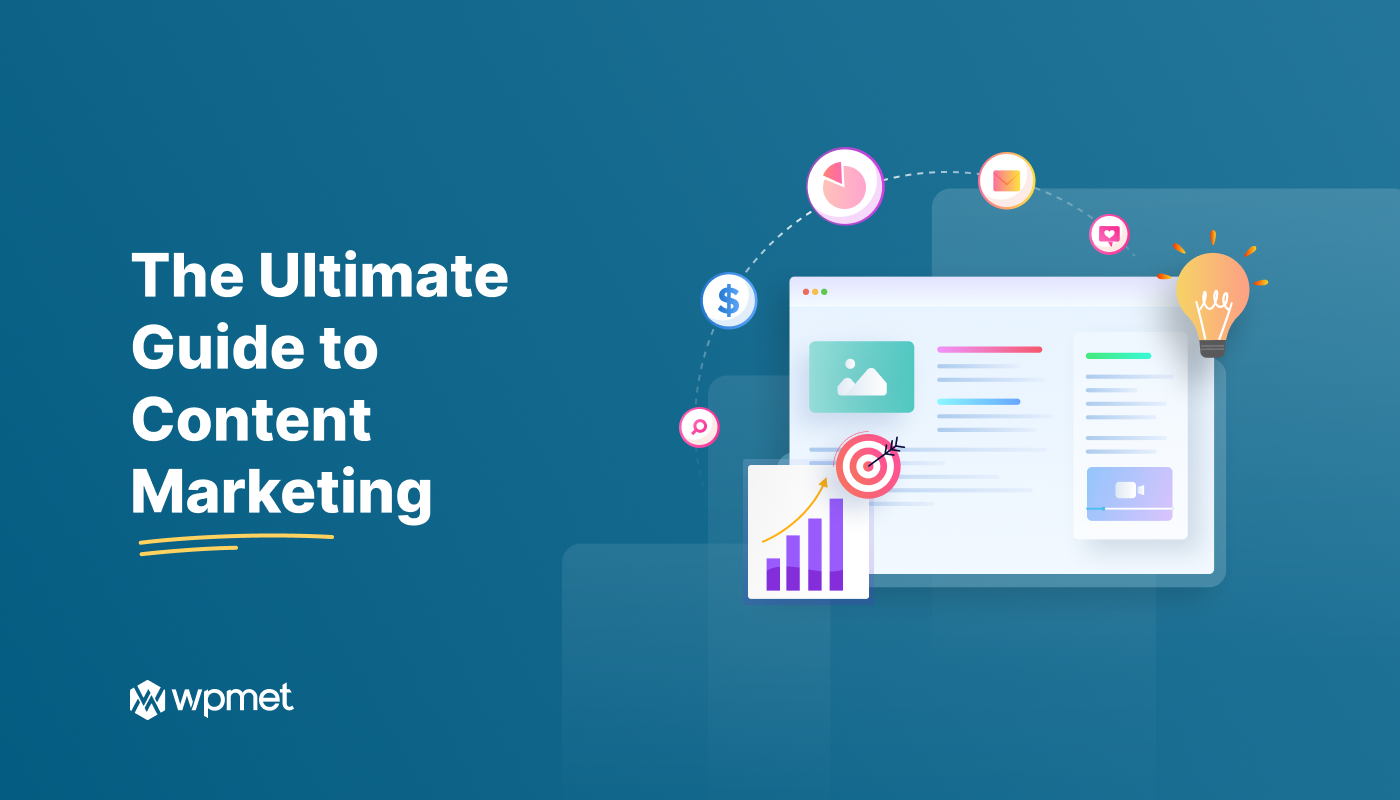You have a variety of well-crafted content pieces in your arsenal. Perhaps you have developed these pieces through blog posts, videos, and social media posts.
But only content creation and publication on respective platforms are unlikely to get you relevant and profitable clicks, traffic, and views, resulting in high conversions. To turn the tables over, you have to develop an effective content marketing strategy and act upon it afterward for all your content types.
Luckily for you, I have put together 10 proven and actionable tips to help you build your content marketing strategy. I have implemented the actions in the tips to develop my business’ content marketing strategy, leading to improved KPIs in no time.
To start off, let’s understand what content marketing is —
Understanding Content Marketing:
Content marketing strategy is your go-to tool for crafting and distributing content to expand your audience and reach various business goals. Various types of content you can leverage to run content marketing for your business–

- Blog posts
- Emails & Newsletters
- Social media posts
- Podcasts
- Ebooks
- Whitepapers
- Visuals
- Videos
The goal of developing a content marketing plan is to send the right message to current and potential customers alongside solving their pain points.
Content marketing precedes a content plan which is a written plan to help you manage your publication and distribution schedule.
Content Marketing– How does it work?
Content marketers appeal to a targetted audience with intriguing stories and by sharing valuable information. They leverage content channels to build community as well.
So, content marketing besides being a technique is also a unique form of communication. To make sure that your content satisfies the audience at every stage, you have to keep the conversion funnel in mind while developing the content.
Top of the Funnel (TOFU) Content:
With the top of the funnel content, your aim is to build awareness among your audience. Your target audience may know they have a problem, but they don’t know how to solve it. At this stage, you should focus on brand awareness, pain points, and common questions.
With the TOFU content, you should grip potential customers to help them better understand a specific problem. This provides you with a relevant opportunity to get them introduced to your solution.
Common challenges for TOFU content encompass competition, balancing educational and promotional content, and tracking ROI.
To deal with these issues, create a content strategy that catches the attention of a specific audience. Your strategy will also let you create a plan that aligns content topics and formats with business goals. Then, produce a list of KPIs to track your content performance.
The following content types are some of the examples of the top of the funnel content:
- Blog posts
- Social media posts
- Short-form video
- Podcasts
- Infographics
- Checklists
- Ebooks
- Webinars
- Video Ads
Middle of the Funnel (MOFU) Content:
Once a prospect enters the middle of the funnel, they are interested in your product. They may have visited your site multiple times or they’re engaging with your social media. Perhaps they have signed up for your email newsletter.
With MOFU content, you should try to build a relationship with that person. At this point, they comprehend their problem and are comparing likely solutions. So, your content should enlighten them on the specifics of your solution and showcase how it meets their unique needs.
This is also a key moment to build trust. A prospect might not be ready to purchase, so pay attention to changes in user behavior. It can be tempting to make guesses or ask them to take actions, but that can affect the relationship. Instead, provide in-depth information and value to nurture your lead.
Examples of the middle-of-funnel content types include:
- Email newsletters
- Product demos
- Landing pages
- White papers
- Case studies
- Longer-form videos
- Blog posts
- Interactive content
- Webinars
Bottom of the Funnel (BOFU) Content:
Bottom-of-the-funnel content assists your prospect in making a decision. That means it helps them make the decision to convert.
With BOFU content, you should make it easy for your audience to test a product, understand pricing, and make a purchase. Content that converts should induce action and create a sense of urgency. Craft your content to respond to common objections and other blockers impacting sales.
Personalization can add to the impact of your content at this stage. Creating powerful CTAs is also important.
Bottom-of-funnel content types include:
- Personalized emails
- User-generated content, like customer testimonials
- Case studies
- Pricing pages
- Competitor comparison blog posts
- Video demos
- White papers
- Remarketing campaigns
Why is Content Marketing Crucial?
One of the HubSpot studies of 2022 reveals that 70% of companies leverage content marketing to grow their businesses.
- Enlightens your leads and prospects about the products and services you offer.
- Scales up your conversions and sales.
- Builds relationships between your customers and business that result in increased loyalty.
- Shows your audience how your products and services solve their pain points.
- Creates a community around your brand.
10 Proven Steps to Creating a Content Marketing Strategy:
The following 10 strategies will help you develop a robust content marketing strategy, boosting your organic traffic and conversions.
1. Set Your Mission and Goals:
The very first step to kick off the content marketing strategy is setting out your mission. It’s a statement briefing who your audience is, how you’ll reach them, and what they’ll achieve from your content.

The following formula can help you set your content marketing mission-
We provide [target audience] with [type of content] to help them [business goals].
For example, a B2B software company could create informational articles on HR rules and regulations (the type of content) for corporate companies (target audience) to help them maintain payroll, leave policies, attendance, etc. of their employees.
You should also emphasize setting SMART goals. That means you should be specific, measurable, attainable, relevant, and time-bound.
However, typical content marketing goals embody amplifying sales, notching up more leads, and increasing traffic.
2. Find your target audience.
Creating content for a broader audience may sound profitable but technically, it’s not. It’s tough to solve the pain points of a wider audience with a piece of content.

Your piece may get high traffic targeting a broad niche but it won’t convert them as they are unlikely to get the solution to their problems from your content.
Instead, focus on a narrow niche with specific interests and needs. This will help you build a community with your content. To kick off, take a look at your buyer personas.
Then, answer the following questions about your target audience that will help you narrow down the right types of content for them–
- What do they need from you?
- What challenges are they looking to get over?
- Why do they need your product or service?
- How can your product or service help them?
- Where do they spend their time?
3. Plan Your Process
Content marketing can’t be executed without mapping out a result-oriented plan. It’s vital to plan a process for content creation. Focus on the following questions to sketch out the content creation process.
- Who’s responsible for creating content?
- Who’s responsible for maintaining and updating content?
- What resources do you need for content development?
- What’s your publishing schedule?
- Who holds the power to approve the final content?
- What is your content creation workflow?
4. Set Your KPIs:
Be sure to set key performance indicators (KPIs) for your SMART goals. KPIs are quantifiable data points you can leverage to measure your actual performance against your goal.
Examples of KPIs encompass revenue targets, numbers of subscribers, increased visitor numbers, and more.

5. Initiate a Blog
Your blog is at the centerpiece of your content marketing strategy. It acts as a driving force for all other content marketing efforts. So, you must have a blog post checklist to nail your blogging. If you don’t already have a blog, consider starting one.
To achieve the most from blogging, you will need some blog post ideas. Some ideas that work well encompass:
- How-to guides
- Comparative content
- Tutorials
- Industry news and insights
- Checklists
- Case studies
- Interviews
- Expert advice
6. Conduct Keyword Research and Produce Content:
Keywords are the terms people use to search for content and it’s important that you do keyword research. In fact, it’s an integral part of creating content as you want people to find your content online when they visit your site. They’re also the terms Google uses to figure out what your content is about.

3 basic types of keywords you can include in your content:
- Seed keywords that identify a broad concept or group of items, like “software”
- Medium keywords, which can be 2 or 3 words that narrow down a concept, like “HR software”
- Long-tail keywords, which are longer, more specific phrases, like “HR software for payroll”
7. Pick Your Content Channels:
After you’ve decided on the type of content you’ll market with, it’s time to pick your specific content channels. Ask yourself where will you share your content and where will it be shared from.
For certain content types, the channel you need to work with will be crystal clear. For example, if you create Facebook content, your channel will be the social network itself.
8. Set a Budget:
Budgeting is a vital part of planning a solid content marketing strategy. But how much to spend on content marketing and what are the most effective ways to set a budget right for you?
Every company’s requirements are unique regarding how much to budget. However, the average company today pumps approximately 25-30 percent of its marketing budget into content marketing, so plan your content production strategy accordingly.
9. Produce and Distribute Content:
It’s time now to create and distribute your content, so your audience and prospects can consume it and possibly convert.

Keep learning to make your content as useful and catchy as you can. Learn to write killer headlines and captivating intros. Make the most of the latest content trends and build aptitude in the media that your audience favors.
Next, optimize your content to make it easy for your audience to find in the SERP. Every social media platform is unique, so check out useful tips to succeed on channels like Facebook, Instagram, TikTok, and LinkedIn.
Finally, don’t forget to promote your content via email, social media, and so forth. Connect with influencers, build co-marketing partnerships, and post ads to grab attention on your best-converting content.
10. Analyze and Gauge Outcomes:
Last but not least, analyze and measure your results so you can make any necessary tweaks to amplify your content marketing efforts and reach more audience members.
Go back to your SMART goals and KPIs to track the success of your content marketing strategy. Figure out and understand if you achieve your goals and KPIs. What went wrong? Were you close to reaching them?
Content Marketing Examples
Ideas always don’t keep flowing. Sometimes, you need inspiration to pull off your efforts. The following content marketing examples will open up your mind–
HubSpot for Varying Content Types:
HubSpot is a perfect example of how to perform content marketing. The company executes content marketing by—
- Writing detailed blog posts that meet their visitors’ requirements
- Uploading Facebook videos and driving traffic to them with LinkedIn
- Leveraging ebooks as lead magnets
Shutterstock for Visual Content:
Shutterstock has a collection of elegant as well as dynamic images and its visual content is also some of the best on the web.
The stock photography website not only contains a massive library of imagery but also scores of variations of a particular image type.
The images are creative, colorful, and appealing too. Owing to so many perks, it’s understandable why it generates tens of thousands of social media shares and visits to its website.
Hootsuite for Videos:
Cracking video content marketing can do wonders for your content marketing efforts. To start with, playing off of what’s already popular is a great way to show your company is coping with times.
It’s also a great opportunity to showcase your intellect, humor, and mastery of what it takes to make a lasting connection with an audience.
Hootsuite follows effective video content marketing strategies. The following one is a classic HootSuite marketing video that played perfectly off the then-popularity of HBO’s Game of Thrones to narrate the company’s brand story.
Build Your Content Marketing Strategy Now:
Content has the power to educate as well as convert your target audiences. But for that, you must strategize both content creation and distribution. Unplanned and inconsistent content pieces are unlikely to hit the goals you set beforehand.
So, gear up to develop a content marketing strategy to reap the benefits from your content. To create valuable content pieces, an AI writing tool can come in handy. With GetGenie, you can generate top-grade content in a matter of seconds and minutes, depending on the content type.


Leave a Reply